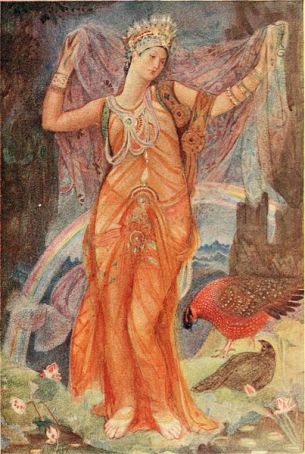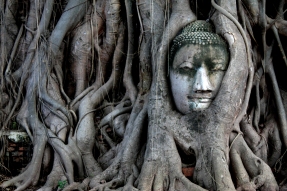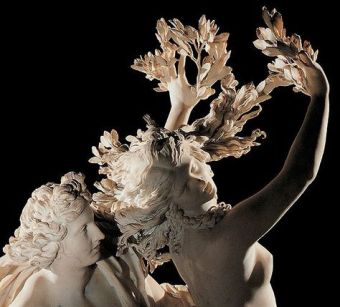by K.P. Kulski
In ancient mythologies, goddesses dominate the dark depths of the Earth. Early civilizations based particularly in Mesopotamia, the Mediterranean and Europe strongly associate the Earth with primordial forces of creation. In past articles I’ve discussed the ancient associations with wombs and the underground. Yet these are extremely cyclic and dualistic. Essentially, in the eyes many ancient belief systems, one cannot have death without birth, birth without death.
In the same vein, mother goddesses are just as prevalent as goddesses of death. Whether it be the womb or the grave, both sides have dark overtones. But understandably, goddesses of death also reign over the underworld, therefore have direct a connection with darkness. We tend to see death/dark goddesses as counterparts to goddesses that represent life or the living. I’d argue that we are thinking about it in reverse and instead those goddesses of life are counterparts to death. In some cases, such as Nyx (which I will discuss more below), dark goddesses are not directly linked to death, but instead with the lack of life and light. Or even a state that existed before creation. So importantly, these are goddesses that existed and reigned long before life itself.
 The Sumerian Ereshkigal is one of the earliest examples of an underground death goddesses. She is featured prominently in the Descent of Inanna, as her sister who ultimately slays Inanna and hangs the body on a meat hook along the wall of the afterlife. Inanna’s journey to the underworld is a process of stripping away parts of herself, culminating eventually in the stripping of her very life. Ereshkigal slays her sister because all those who enter the underworld must experience death. “She who receive the me of the underworld does not return. She who goes to the Dark City stays there.”[1] It hits on the great mystery almost all of us wonder, what happens after life? If anything? Of course, the answer to this comes with great cost.
The Sumerian Ereshkigal is one of the earliest examples of an underground death goddesses. She is featured prominently in the Descent of Inanna, as her sister who ultimately slays Inanna and hangs the body on a meat hook along the wall of the afterlife. Inanna’s journey to the underworld is a process of stripping away parts of herself, culminating eventually in the stripping of her very life. Ereshkigal slays her sister because all those who enter the underworld must experience death. “She who receive the me of the underworld does not return. She who goes to the Dark City stays there.”[1] It hits on the great mystery almost all of us wonder, what happens after life? If anything? Of course, the answer to this comes with great cost.
The Norse goddess Hel, dwells in Niflheim where she presides over the dead who were not chosen for Odin’s Valhalla or Freyja’s Fólkvangr. Meaning, she presides over the dead who did not die in battle or do not have what would qualify as a noble death. Hel’s realm doesn’t offer the feeling of continuance like Valhalla and Fólkvangr, it is a rather final, inglorious, an eternal state of dark. Even Baldur, one of the most loved of the gods cannot easily escape Hel’s realm. When the gods sought his return to the living, Hel declared she would only allow it if all things grieved for him. Note, she held dominion over death and not even the gods could make demands of her. Of course, someone wasn’t all that big of a fan of Baldur and did not grieve, so he continued to be quite dead.
The Greek goddess Nyx mentioned above, is an excellent example of a goddess of darkness, or in this case, specifically the goddess of the night. While she is not  specifically linked to death, her nature is ultimately both primordial and dualistic. She existed before the world was created. Her identity is both the absence of light as well as the absence of order and one can further compare a symbolic connection to life and death cycles. Interestingly enough, Nyx is believed to have been the mother of the incarnations of light and day. Again, the dualistic existence is prominent. Cycles are of utmost importance as one exists alongside the other.
specifically linked to death, her nature is ultimately both primordial and dualistic. She existed before the world was created. Her identity is both the absence of light as well as the absence of order and one can further compare a symbolic connection to life and death cycles. Interestingly enough, Nyx is believed to have been the mother of the incarnations of light and day. Again, the dualistic existence is prominent. Cycles are of utmost importance as one exists alongside the other.
The Greek goddess Persephone contains this dualistic nature within one figure. She is both the goddess of spring (and therefore renewal and life), but cyclically dwells with her husband Hades in the underworld. Her absence on the surface brings the seasonal “death” of Autumn and Winter. (Check out other Unbound articles on Persephone here and here.)
These goddesses held such power that even the other deities in their pantheons were not immune from them. Burial of the dead is much like returning to the womb, to the dark sacred space of mystery.
To the ancients, the two states weren’t much different.
_______________________________________
[1] Diane Wolkstein and Samuel Noah Kramer, eds., Inanna Queen of Heaven and Earth: Her Stories and Hymns From Sumer, (New York: Harper & Row, 1983), 61.
Featured image credit: Demonic Paradise


 pagan movement of modern day), the Bodhi Tree, its very name meaning the awakening or enlightenment of Buddha, and the Tree of Knowledge of the Judaic tradition. In each depiction, there are strong connections to humanity and the human experience. While the divine, or immortal may be connected to the tree, it is often in a human-like capacity that ascends into some type of enlightenment (in the case of monotheism, knowledge that leads to disaster). This can be explained by the idea that the tree is a mirror of humanity itself – ever rooted to the Earth by reaching for something greater, something higher, caught in a state in-between.
pagan movement of modern day), the Bodhi Tree, its very name meaning the awakening or enlightenment of Buddha, and the Tree of Knowledge of the Judaic tradition. In each depiction, there are strong connections to humanity and the human experience. While the divine, or immortal may be connected to the tree, it is often in a human-like capacity that ascends into some type of enlightenment (in the case of monotheism, knowledge that leads to disaster). This can be explained by the idea that the tree is a mirror of humanity itself – ever rooted to the Earth by reaching for something greater, something higher, caught in a state in-between. repetitive in Western culture. I’d like to examine these through the lens of the Greek myth of Daphne, the nymph lustfully pursued by Apollo until she is transformed into the laurel tree in order to escape. It is a timely myth to revisit for the modern audience, as many women via the Me Too movement have spoken out against male sexual misconduct, particularly from powerful men. It has spurred not only conversations on the sexual harassment, pressure and assault on women, but questions concerning sex and power dynamics.
repetitive in Western culture. I’d like to examine these through the lens of the Greek myth of Daphne, the nymph lustfully pursued by Apollo until she is transformed into the laurel tree in order to escape. It is a timely myth to revisit for the modern audience, as many women via the Me Too movement have spoken out against male sexual misconduct, particularly from powerful men. It has spurred not only conversations on the sexual harassment, pressure and assault on women, but questions concerning sex and power dynamics. greater, a life-threatening or ruining possibility.
greater, a life-threatening or ruining possibility. Daphne is described as athletic and when she flees, she gives a difficult pursuit for Apollo. But he is ultimately a god, so he is able to gain ground on her. Despite Daphne’s abilities, she cannot escape Apollo’s will. We could read this as despite female abilities and potential, women cannot escape society’s will.
Daphne is described as athletic and when she flees, she gives a difficult pursuit for Apollo. But he is ultimately a god, so he is able to gain ground on her. Despite Daphne’s abilities, she cannot escape Apollo’s will. We could read this as despite female abilities and potential, women cannot escape society’s will.
 the withdrawal of God’s protection. In Celtic culture, trees, or a grove can serve as a gateway to the realm of the faery, a mysterious world of amazement and entrapment, rife with equal parts wonder and danger. Such transformations and withdrawal from societal cooperation are by nature threatening to that society, but there is a freedom that can be found.
the withdrawal of God’s protection. In Celtic culture, trees, or a grove can serve as a gateway to the realm of the faery, a mysterious world of amazement and entrapment, rife with equal parts wonder and danger. Such transformations and withdrawal from societal cooperation are by nature threatening to that society, but there is a freedom that can be found. I met a lady in the meads,
I met a lady in the meads, warning to men of what could happen if women were allowed such self-direction. Indeed it hints at the very destruction of male power structures, “…pale kings and princes too, pale warriors, death-pale were they all.”
warning to men of what could happen if women were allowed such self-direction. Indeed it hints at the very destruction of male power structures, “…pale kings and princes too, pale warriors, death-pale were they all.”


